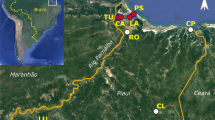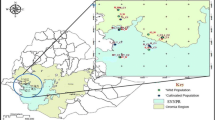Abstract
Ramie (Boehmeria nivea) was domesticated in China. However, the geographic region of domestication is not exactly known. Genetic diversity and population structure of ramie and their wild relatives were assessed using microsatellite markers. The 8 microsatellite primers revealed 96 alleles in 50 ramie populations, with an average of 10.25 alleles per locus. Cultivated ramie gene pool harbors approximately 82.9 % of the SSR diversity presented in wild B. nivea var. nivea. It is suggested that ramie has experienced a relatively moderate domestication bottleneck. The distribution of genetic diversity shows that genetic diversity is relatively high in populations along the Yangtze River compared to the peripheral ones. The scatter plots of principal coordinates analysis indicated that there are three well-supported varieties in B. nivea. The NJ tree and the distribution of genetic diversity showed that ramie has been domesticated in the middle and lower regions of the Yangtze valley, and populations in Sichuan province have been introduced from this region, forming naturalized populations.






Similar content being viewed by others
References
Ahuja SL (1988) Association and path-coefficient studies on vegetatively propagating and sexually reproducing parts in ramie (Boehmeria nivea L. Gaud.). Sex Plant Reprod 1:63–64
Benbouza H, Jacquemin JM, Baudoin JP, Mergeai G (2006) Optimization of a reliable, fast, cheap and sensitive silver staining method to detect SSR markers in polyacrylamide gels. Biotechnol Agron Soc Environ 10:77
Doebley JF, Gaut BS, Smith BD (2006) The molecular genetics of crop domestication. Cell 127:1309–1321
Duan SW, Liu ZC, Feng XY, Zheng K, Cheng LF, Zheng X (2012) Diversity and characterization of ramie-degumming strains. Scientia Agricola 69:119–125
Dudaniec RY, Storfer A, Spear SF, Richardson JS (2010) New microsatellite markers for examining genetic variation in peripheral and core populations of the coastal giant salamander (Dicamptodon tenebrosus). PLoS ONE 5:e14333
Guo AP, Zhou P, Peng SQ, Zheng XQ (2001) Factors affecting the reaction system of RAPD analysis in Boehmeria Jacq. Chin J Trop Crops 22:64–69
Guo XB, Zang GG, Zhao LN, Cheng CH, Li YJ (2008) Improvement of the extraction method of genomic DNA of wild species of Boehmeria nivea (Linn.) Gaudich. Plant Fiber Sci China 30:28–32
Jiang YB, Jie YC (2005) Advances in research on the genetic relationships of Boehmeria in China. J Plant Genet Res 6:114–118
Jiang YB, Jie YC, Zhou JL, Xing HC, She W (2007) Isolation and characterization of microsatellites from ramie [Boehmeria nivea (L.) Gaud.]. Acta Agronomica Sinica 22:158–162
Kalinowski ST (2005) Hp-rare 1.0: a computer program for performing rarefaction on measures of allelic richness. Mol Ecol Notes 5:187–189
Kuhn D (1988) Science and civilisation in China. Cambridge University Press, London
Kuroda Y, Kaga A, Tomooka N, Vaughan D (2010) The origin and fate of morphological intermediates between wild and cultivated soybeans in their natural habitats in Japan. Mol Ecol 19:2346–2360
Li HL (1970) The origin of cultivated plants in Southeast Asia. Econ Bot 24:3–19
Li JJ, Guo QQ, Chen JR (2006) Rapd analysis of lignin content for 21 ramie varieties. Plant Fibers Prod 28:120–127
Li TJ, Xu LL, Pan QL, Lai ZJ, Liao L (2008) Study advances on the systematics of Boehmeria. Jiangxi For Sci Technol 2:32–35
Liao L, Li TJ, Liu ZL, Deng HS, Xu LL, Pan QH, Lai ZJ, Shi QH (2009) Phylogenetic relationship of ramie and its wild relatives based on cytogenetic and DNA sequence analyses. Acta Agronomica Sinica 35:1778–1790
Liao L, Li TJ, Zhao ZW, Chen YB, Xu LL, Pan QH, Shi QH (2010) Phylogenetic relationship of ramie and its wild relatives based on SRAP markers. Guihaia 30:791–795
Liu K, Muse SV (2005) Powermarker: an integrated analysis environment for genetic marker analysis. Bioinformatics 21:2128–2129
Liu FH, Li Z, Liu Q, He H, Liang X, Lai Z (2003) Introduction to the wild resources of the genus Boehmeria Jacq. in China. Genet Resour Crop Evolut 50:793–797
Liu LJ, Meng ZQ, Xing XL, Peng DX (2006) Optimization for srap reaction system in ramie (Boehmeria nivea (L.) Gaud.). Mol Plant Breed 4:726–730
Liu LJ, Peng DX, Wang B (2008) Genetic relation analysis on ramie [Boehmeria nivea (L.) Gaud.] Inbred lines by SRAP markers. Agric Sci China 7:944–949
Liu L, Meng ZQ, Wang B, Wang X, Yang JY, Peng D (2009) Genetic diversity among wild resources of the genus Boehmeria Jacq. From West China determined using inter-simple sequence repeat and rapid amplification of polymorphicDNA markers. Plant Prod Sci 12:88–96
Liu F, Yao J, Wang X, Repnikova A, Galanin DA, Duan D (2012) Genetic diversity and structure within and between wild and cultivated Saccharina japonica (Laminariales, Phaeophyta) revealed by SSR markers. Aquaculture 358:139–145
Mandel J, Dechaine J, Marek L, Burke J (2011) Genetic diversity and population structure in cultivated sunflower and a comparison to its wild progenitor, Helianthus annuus L. Theor Appl Genet 123:693–704
Matus IA, Hayes PM (2002) Genetic diversity in three groups of barley germplasm assessed by simple sequence repeats. Genome 45:1095–1106
Muraya MM, de Villiers S, Parzies HK, Mutegi E, Sagnard F, Kanyenji BM, Kiambi D and Geiger HH (2011) Genetic structure and diversity of wild sorghum populations (Sorghum spp.) From different eco-geographical regions of Kenya. Theor Appl Genet 123:571–583
Peakall R, Smouse PE (2006) Genalex 6: genetic analysis in excel. Population genetic software for teaching and research. Mol Ecol Notes 6:288–295
Sen T, Reddy HN (2011) Various industrial applications of hemp, kinaf, flax and ramie natural fibres. IJIMT 2:192–198
Sun ZM, Zhang B (1999) Stipule morphology and classification value in Boehmeria Jacq. China’s Fiber Crops 21:17–19
van Zonneveld M, Scheldeman X, Escribano P, Viruel MA, Van Damme P, Garcia W, Tapia C, Romero J, Sigueñas M, Hormaza JI (2012) Mapping genetic diversity of cherimoya (Annona cherimola Mill.): application of spatial analysis for conservation and use of plant genetic resources. PLoS ONE 7:e29845
Vavilov NI (1992) Origin and geography of cultivated plants. Cambridge University Press, Cambridge
Vigouroux Y, Mitchell S, Matsuoka Y, Hamblin M, Kresovich S, Smith JSC, Jaqueth J, Smith OS, Doebley J (2005) An analysis of genetic diversity across the maize genome using microsatellites. Genetics 169:1617–1630
Wang WT (1981a) Revisio Boehmeriae sinicae. Acta Botanica Yunnanica 3:307–328
Wang WT (1981b) Revisio Boehmeriae sinicae (cont.). Acta Botanica Yunnanica 3:401–416
Weir BS (1996) Genetic data analysis II: methods for discrete population genetic data. Sinauer Assoc. Inc., Sunderland
Wright SI, Bi IV, Schroeder SG, Yamasaki M, Doebley JF, Mcmullen MD, Gaut BS (2005) The effects of artificial selection on the maize genome. Science 308:1310–1314
Wu ZY, Raven PH, Hong DY (2003) Flora of China. Volume 5: ulmaceae through Basellaceae. Science Press, Beijing
Xing XL (2008) Development of microsatellite markers from ramie and its application for preliminary study of heterosis forecast. Wuhan, Huazhong Agricultural University, Master thesis
Zhang J, Li TJ, Cao B, Xu LL, Liao L (2012) Development of ramie EST-SSR primers and high morphic loci analysis. Jiangsu Agric Sci 40:25–27
Zhao CY, Li JS (1999) Evaluation and utilization of resources of ramie in Qinba mountain area. Acta Agriculturae Boreali Occidentalis Sinica 8:116–118
Acknowledgments
We would like to thank institute of bast fiber crops, Chinese academy of agricultural sciences for providing materials. This work was supported by National Natural Science Foundation of China (NSFC30860027) and Natural Science Foundation of Jiangxi Province (2009GZN0080).
Author information
Authors and Affiliations
Corresponding author
Additional information
Liang Liao and Tongjian Li have contributed equally.
Rights and permissions
About this article
Cite this article
Liao, L., Li, T., Zhang, J. et al. The domestication and dispersal of the cultivated ramie (Boehmeria nivea (L.) Gaud. in Freyc.) determined by nuclear SSR marker analysis. Genet Resour Crop Evol 61, 55–67 (2014). https://doi.org/10.1007/s10722-013-0014-0
Received:
Accepted:
Published:
Issue Date:
DOI: https://doi.org/10.1007/s10722-013-0014-0




